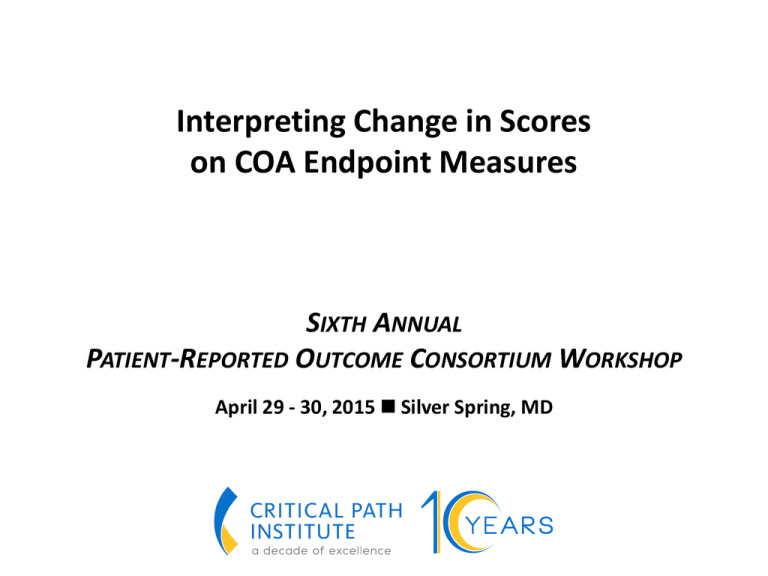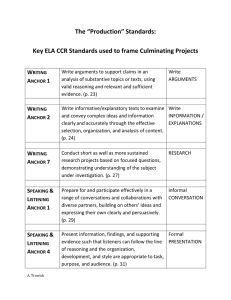
Interpreting Change in Scores
on COA Endpoint Measures
SIXTH ANNUAL
PATIENT-REPORTED OUTCOME CONSORTIUM WORKSHOP
April 29 - 30, 2015 Silver Spring, MD
Disclaimer
The views and opinions expressed in the following
slides are those of the individual presenters and
should not be attributed to their respective
organizations/companies, the U.S. Food and Drug
Administration, the Critical Path Institute, the PRO
Consortium, or the ePRO Consortium.
These slides are the intellectual property of the
individual presenters and are protected under the
copyright laws of the United States of America and
other countries. Used by permission. All rights
reserved. All trademarks are the property of their
respective owners.
Session Participants
— Cheryl D. Coon, PhD
• Director, Healthcare Analytics, Adelphi Values
— Joseph C. Cappelleri, PhD, MPH
• Senior Director of Biostatistics, Pfizer Inc
— Scott Komo, DrPH
• Senior Statistical Reviewer, Office of Biostatistics, CDER,
FDA
— Laura Lee Johnson, PhD
• Associate Director, Division of Biometrics III, Office of
Biostatistics, CDER, FDA
Session Overview
1. Present a brief history on interpreting change in
scores on COA measures used as endpoints
2. Illustrate two anchor-based methods for defining
clinically important responders
3. Discuss three novel methods for interpreting
change that could be added to our toolbox
4. Provide regulatory reflection on interpreting COA
scores in a clinical trial
History
• While the difference between treatment groups can be evaluated
using significance tests, thresholds are needed to interpret if
change on a COA is meaningful
• Minimal (clinically) important difference (MID or MCID) was
introduced in the 1980’s to determine the smallest amount of
change that patients perceive as a benefit1
• Draft FDA PRO guidance in 2006 covered both MID for group-level
change and a responder definition for individual-level change
• Final FDA PRO guidance in 2009 focused only on responder and
individual-level change
1Jaeschke
et al. Control Clin Trials. 1989;10(4):407-15.
Semantics
• Confusion arises because the term MID is often used in
reference to both individual-level change and group-level
differences
• Further, shouldn’t we be striving for “important” change
rather than “minimal” change?
– “Minimal” is vague, and there was consensus at a recent gathering of
psychometricians in our field that we should refrain from using this
term
• Thus, some realignment is needed on the semantics for
interpreting change on COAs
Semantics
• Group-level change: Clinically important difference (CID)1 is
the difference in change scores between two treatment
groups, or the change score within one treatment group, that
can be considered clinically important
• Individual-level change: Clinically important responder (CIR)
threshold1 is the amount of change a patient would have to
report to indicate that a treatment benefit has been
experienced
• The FDA Guidance tends to focus on individual-level change,
and so shall this session
1Cappelleri
et al. Patient-Reported Outcomes: Measurement, Implementation and Interpretation. 2013.
Mainstream Approaches for Defining a
Responder Threshold
• Anchor-based methods: Anchor change scores on the COA to
an external criterion that identifies study subjects who have
experienced an important change in their condition
• Distribution-based methods: Use the distribution of COA
scores to classify the size of meaningful change rather than
the statistical or clinical significance of that change
• Cumulative distribution functions (CDFs): For each possible
change score on the COA, plot the percentage of subjects
achieving that amount of improvement or greater and
examine the separation between groups for each possible
threshold
Limitations with Mainstream
Approaches
• Anchor-based methods: A meaningful and sufficiently-related
(i.e., correlated) anchor is not always available in our studies
• Distribution-based methods: This approach does not connect
back to the patient perspective and is more related to scale
precision
• CDFs: This approach also does not connect back to the patient
perspective, and there’s misunderstanding in how to interpret
them
Are there novel or interesting methods that we should
be considering for interpreting change on COAs?
Two Methods for Responder Analysis
of Patient-Reported Outcome Measures
Joseph C. Cappelleri, PhD, MPH
Senior Director of Biostatistics, Pfizer Inc
SIXTH ANNUAL
PATIENT-REPORTED OUTCOME CONSORTIUM WORKSHOP
April 29 - 30, 2015 Silver Spring, MD
How Do You Determine the
Responder Definition for a PRO
Instrument?
Anchor-Based Methods
• Anchor-based methods explore the association
between the PRO measure of interest and an anchor
measure
• To be useful, the anchors chosen should be easier to
interpret than the PRO measure itself and be
appreciably correlated with it
• Magnitude of responder definition on a PRO
measure depends on its correlation with the anchor,
its variability, and the variability of the anchor
Two Anchor-Based Approaches
• One using logistic regression
– Anchor is binary outcome
– PRO measure is quantitative predictor
– Receiver Operating Characteristic (ROC) Curve
• Another using linear regression
– PRO measure is quantitative outcome
– Anchor predictor could be quantitative or categorical
– Cross-sectional model or longitudinal model
ROC Curve Illustration (Logistic Regression):
Pain Intensity Numerical Rating Scale (PI-NRS)
• Farrar JT et al. Pain 2001; 94:149-158
• 11-point pain scale: 0 = no pain to 10 = worst pain
–
–
–
–
Baseline score = mean of 7 diary entries prior to drug
Endpoint score = mean of last 7 diary entries
Interest centers on change score
Primary endpoint in pregabalin program
• 10 chronic pain studies with 2724 subjects
– Placebo-controlled trials of pregabalin
– Several conditions (e.g., fibromyalgia and osteoarthritis)
ROC Illustration: PI-NRS
• Patient Global Impression of Change (anchor)
– Clinical improvement of interest
– Best change score for distinguishing ‘much improved’ or
better on PGIC
• Since the start of the study, my overall status is:
1.
2.
3.
4.
5.
6.
7.
Very much improved
Much improved
Minimally improved
No change
Minimally worse
Much worse
Very much worse
Arrow below indicates sensitivity & specificity for two-point improvement or 30% improvement
Longitudinal Illustration (Repeated Measures
Linear Regression): Itch Severity Score
• Consistent with FDA guidance with respect (as could be the
logistic regression approach)
• Mamolo et al. Journal of Dermatological Treatment. In press.
doi:10.3109/09546634.2014.906033.
• Clinically important responder on the Itch Severity Scale (ISS)
• Itch Severity Score was the outcome
– A 11-point numeric rating (0=no itching to 10=worst
possible itching)
Longitudinal Illustration:
Itch Severity Score
• Anchor involved two steps
• Step One
– Patient Global Assessment (PtGA)
– Evaluates the overall extent of cutaneous disease at a given time,
with categories of ‘‘clear’’, ‘‘almost clear’’, ‘‘mild’’, ‘‘moderate’’ and
‘‘severe’’
• Step Two
– Use PtGA to create the Subject Global Impression of Change (SGIC)
– Compare post-baseline PtGA relative to baseline PtGA
– If improve, define SGIC as ‘‘better’’ (1); if worse, define SGIC as
“worse” (-1); if unchanged, define SGIC as “the same” (0)
– SGIC motivated by FDA Guidance on PRO measures
Longitudinal Illustration:
Itch Severity Score
• A repeated-measures model was used to estimate the
relationship between percent change from baseline ISS and
the SGIC as an anchor
• Assessed at baseline and weeks 4, 8, 12 and 16
• The percent difference on the ISS corresponding to a onecategory change on the SGIC was used to define a clinically
important responder
• It was estimated to be 29.85% (95% CI: 23.30, 36.40) –
approximately a 30% improvement
Results: Proportion of Individuals with at Least
a 30% Improvement
Shaded boxes represent active treatments; white
box represents placebo
Cumulative Distribution Function:
Adjunct to Whichever Anchor Method is Used
• In general, consider cumulative distribution function
for each treatment regardless of responder definition
• Can be applied descriptively for observed data
• Provides a descriptive assessment on robustness of
responder definition
• Part of FDA Guidance on PRO measures
Illustrative Cumulative Distribution Function: Experimental
Treatment (solid line) better than Control Treatment (dash line) -Negative changes indicate improvement
Vertical Arrow:
Difference in
response for a
change of 10 points
or less (better) -- 70%
in experimental vs.
55% in control
Horizontal Arrow:
40% of experimental
subjects had a
change score of -5 or
less (better), while
40% of control
subjects had a
change score of +5
or less (better)
Two General References on
Interpretation
• Cappelleri JC, Bushmakin AG. Interpretation of
patient-reported outcomes. Statistical Methods in
Medical Research. 2014; 23:460-483.
• Cappelleri JC, Zou KH, Bushmakin AG, Alvir JMJ,
Alemayehu D, Symonds T. Patient-Reported
Outcomes: Measurement, Implementation and
Interpretation. Boca Raton, Florida: Chapman &
Hall/CRC Press. 2013.
Summary
• Highlighted and illustrated two methods for defining a
clinically important responder
• Incorporates anchor-based methodology
• Logistic regression (ROC curve)
– Anchor as outcome, target PRO as predictor
– Select responder cutoff on PRO that best distinguishes levels of
the anchor (based on sensitivity and specificity)
• Linear regression
– Target PRO as outcome, anchor as predictor
– Select responder cutoff on PRO that gives the difference in
means between adjacent levels of the anchor
Three Novel Methods for Establishing
Responder Thresholds on COAs
Cheryl D. Coon, PhD
Director, Healthcare Analytics, Adelphi Values
SIXTH ANNUAL
PATIENT-REPORTED OUTCOME CONSORTIUM WORKSHOP
April 29 - 30, 2015 Silver Spring, MD
Considerations in Selecting
Approaches
Beyond anchor-based and distribution-based approaches,
as well as CDFs, are there alternative methods that we
should be considering for interpreting change on COAs?
• What approach should we use when a meaningful
anchor isn’t available?
• What approach should we use when the only available
quantitative data are from a non-interventional study?
• How do we ensure that we are linking change to the
patient perspective?
Alternative Approaches:
Bookmarking/Standard Setting
• A group of patients and experts reviews the items and reaches
a consensus on the location of thresholds for interpreting
scores and change scores
• Example: Cook et al. Qual Life Res. 2015;24(3):575-89.
Advantages
Disadvantages
Does not require an
Requires a stand-alone study
interventional study
Can be cognitively difficult
for participants
Directly ties thresholds to the
patient perspective
Can be inconclusive if the
group fails to reach a
Results can be available
consensus
quickly after data collection
Alternative Approaches:
Exit Interviews
• Subjects whose condition changed over time are recruited
from a longitudinal study, and interviews are conducted to
understand how the change that was experienced influenced
their scores on the COA measure
• Example: No published applications to date?
Advantages
Recruitment uses the pool of subjects
from an already-recruited study
Qualitative data is used to give greater
insight into quantitative results
Patients are available to directly ask if
their scores are reflective of the change
they experienced
Disadvantages
The qualitative data could contradict
the quantitative data and could be
difficult to synthesize
The study is sensitive to recall bias
Timing can be challenging in recruiting
soon after the longitudinal study is
completed
Alternative Approaches:
Conjoint Analysis
• Patient preference data on hypothetical item response
profiles are used to the calculate utilities of actual COA scores
in the clinical trial, and the conjoint model identifies
responders based on their utilities pre- and post-treatment
• Example: Coon et al. 17th Annual ISOQOL Conference. 2010.
Advantages
Disadvantages
Does not require an interventional
Requires a stand-alone study
study
Can be cognitively difficult for
Directly ties responder definitions to the
participants
patient perspective
Needs a limited number of items and
Responder definitions are sensitive to
response categories to be able to fit the
pre-treatment scores
model
Does not result in one CIR threshold on
the same metric as the COA
Summary
• Researchers in our field are considering innovative
approaches for interpreting change on COAs
– These approaches can complement mainstream approaches,
providing further insight into the meaning of change
• There are pros and cons to each approach, and it is
important to acknowledge limitations while also being
open to original or supplementary methods
• Regardless of which methods are implemented,
justification for and the value of the selected methods
should be documented
Topics for Discussion
1.
Should CIR be used as the primary metric for evaluating COA
endpoints, or should it be used to supplement statistical methods
that treat the COA as a continuous measure?
2.
When is group-level interpretation (i.e., CID) preferred over
individual-level interpretation (i.e., CIR)?
3.
The same methodology has been used to identify one threshold
that defines both CID and CIR. Is that appropriate?
4.
Are there other examples where innovative methods have been
used successfully to assess CIR (or CID) for supporting endpoints?
5.
Is it preferable to include standardized effect sizes (i.e., difference
within or between groups, divided by variability) to accompany
CID and CIR?
6.
What approaches would YOU (the audience) recommend?
Discussion and/or
Questions?
Session Participants
— Cheryl D. Coon, PhD
• Director, Healthcare Analytics, Adelphi Values
— Joseph C. Cappelleri, PhD, MPH
• Senior Director of Biostatistics, Pfizer Inc
— Scott Komo, DrPH
• Senior Statistical Reviewer, Office of Biostatistics, FDA
— Laura Lee Johnson, PhD
• Associate Director, Division of Biometrics III, Office of
Biostatistics, FDA



